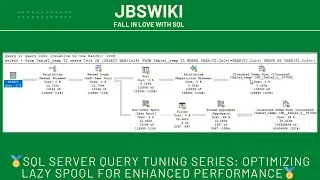🏅SQL Server Query Tuning Series: Optimizing Lazy Spool for Enhanced Performance🏅
на канале: JBSWiki
Welcome to the SQL Server Query Tuning Series! In this in-depth tutorial, we will dive into the intricacies of SQL Server execution plans with a particular focus on the Lazy Spool operator. We will explore the issues associated with Lazy Spool, methods to avoid it, and how doing so can significantly boost your database performance. Let's get started! 🧑💻📈
1. Introduction to SQL Server Query Tuning 📚
SQL Server query tuning is a crucial aspect of database administration and development. Optimized queries not only improve performance but also enhance the overall efficiency of your applications. In this series, we aim to cover various techniques and strategies to fine-tune SQL Server queries, starting with a deep dive into the Lazy Spool operator. Let's embark on this journey to make your SQL Server instances run faster and more efficiently! 🚀
2. Understanding Execution Plans 🔍
Importance of Execution Plans 📊
Execution plans are like blueprints for SQL Server queries. They provide a detailed roadmap of how the SQL Server query optimizer executes a query. Understanding these plans is essential for identifying performance bottlenecks and optimizing queries. Execution plans can reveal:
Index Usage: Are the right indexes being used? 📚
Join Methods: Are the join operations efficient? 🔗
Data Retrieval Methods: How is the data being accessed? 📦
Reading Execution Plans 👀
Reading execution plans involves interpreting various operators and their costs. Key elements to focus on include:
Estimated Cost: A measure of resource usage (CPU, I/O, etc.) 🖥️
Actual vs. Estimated Rows: Discrepancies can indicate issues 🔍
Operator Types: Different operations like scans, seeks, joins, and spools 🔄
In this section, we'll provide a comprehensive guide on how to read and analyze execution plans, setting the stage for understanding the Lazy Spool operator.
3. The Role of the Spool Operator 🎭
The Spool operator in SQL Server is a temporary storage mechanism used by the query optimizer. It can store intermediate results for reuse during query execution. There are several types of spool operators, including:
Table Spool: Stores rows of a table temporarily 🗂️
Index Spool: Temporarily builds an index on the fly 📑
Row Count Spool: Used for certain counting operations 🔢
Introduction to Lazy Spool 🐢
The Lazy Spool operator is a type of Table Spool. It lazily evaluates and stores rows only when they are needed, rather than upfront. While this can be beneficial in certain scenarios, it often leads to performance issues due to increased I/O and memory usage. Understanding how and when Lazy Spool is used is key to identifying and addressing potential performance bottlenecks.
4. Issues with Lazy Spool ⚠️
Performance Overhead 🏋️
Lazy Spool can introduce significant performance overhead by causing unnecessary I/O operations and increasing CPU usage. This can lead to:
Slower Query Performance: Delayed execution due to on-demand row storage ⏳
Increased Resource Consumption: More CPU and memory usage 💻
Resource Utilization 💾
Lazy Spool can also lead to inefficient resource utilization, particularly in high-concurrency environments. Key issues include:
Memory Pressure: Increased memory usage for temporary storage 🧠
Disk I/O: More frequent access to disk storage, affecting overall system performance 💿
Common Scenarios Triggering Lazy Spool 🔄
Lazy Spool is often triggered in scenarios such as:
Recursive Queries: Common in hierarchical data retrieval 🌳
Complex Joins: When joining large datasets with complex conditions 🔗
Subqueries: Particularly correlated subqueries 🔍
Identifying these scenarios can help in understanding when Lazy Spool might be impacting performance.
5. Strategies to Avoid Lazy Spool 💡
Avoiding Lazy Spool often involves optimizing the underlying query structure and database design. Key strategies include:
Index Optimization 📑
Effective indexing can minimize the need for spooling by allowing more efficient data retrieval. Tips include:
Create Appropriate Indexes: Ensure indexes align with query predicates and join conditions 📊
Use Covering Indexes: Reduce the need for additional lookups 📋
Maintain Indexes Regularly: Rebuild or reorganize indexes to ensure they remain efficient 🔧
Query Rewriting 📝
Rewriting queries to be more efficient can also help avoid Lazy Spool. Techniques include:
Simplify Complex Joins: Break down complex joins into simpler, more efficient ones 🔄
Optimize Subqueries: Transform correlated subqueries into joins where possible 🔄
Use Common Table Expressions (CTEs): For better readability and performance 🌐
Utilizing TempDB Efficiently 📂
Efficient use of TempDB can also mitigate the impact of Lazy Spool. Tips include:
Monitor TempDB Usage: Keep an eye on TempDB performance and utilization 📊
Optimize TempDB Configuration: Use multiple data files, set appropriate autogrowth settings, and place TempDB on fast storage 💾
Minimize TempDB Contention: Reduce the number of operations that rely heavily on TempDB 🚫































